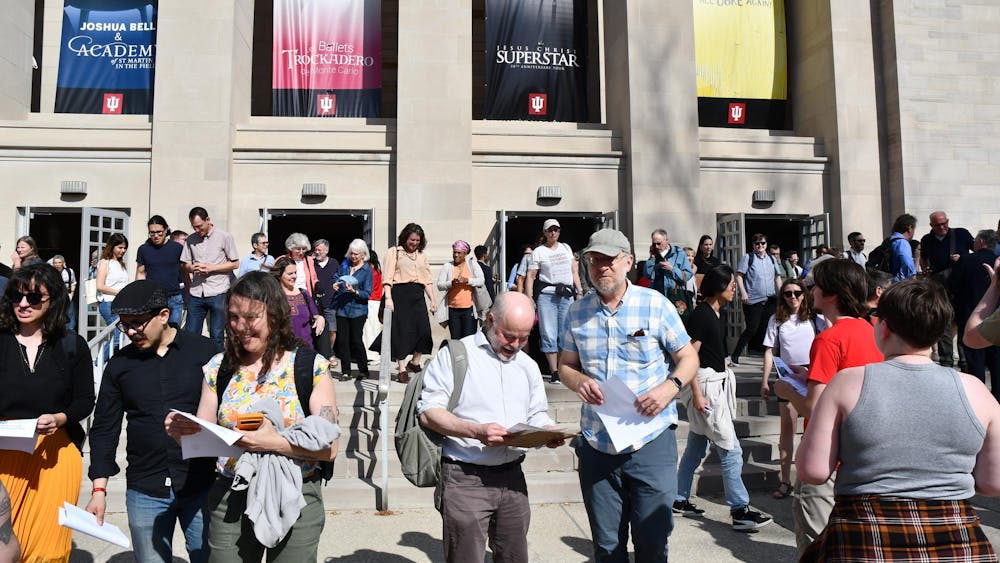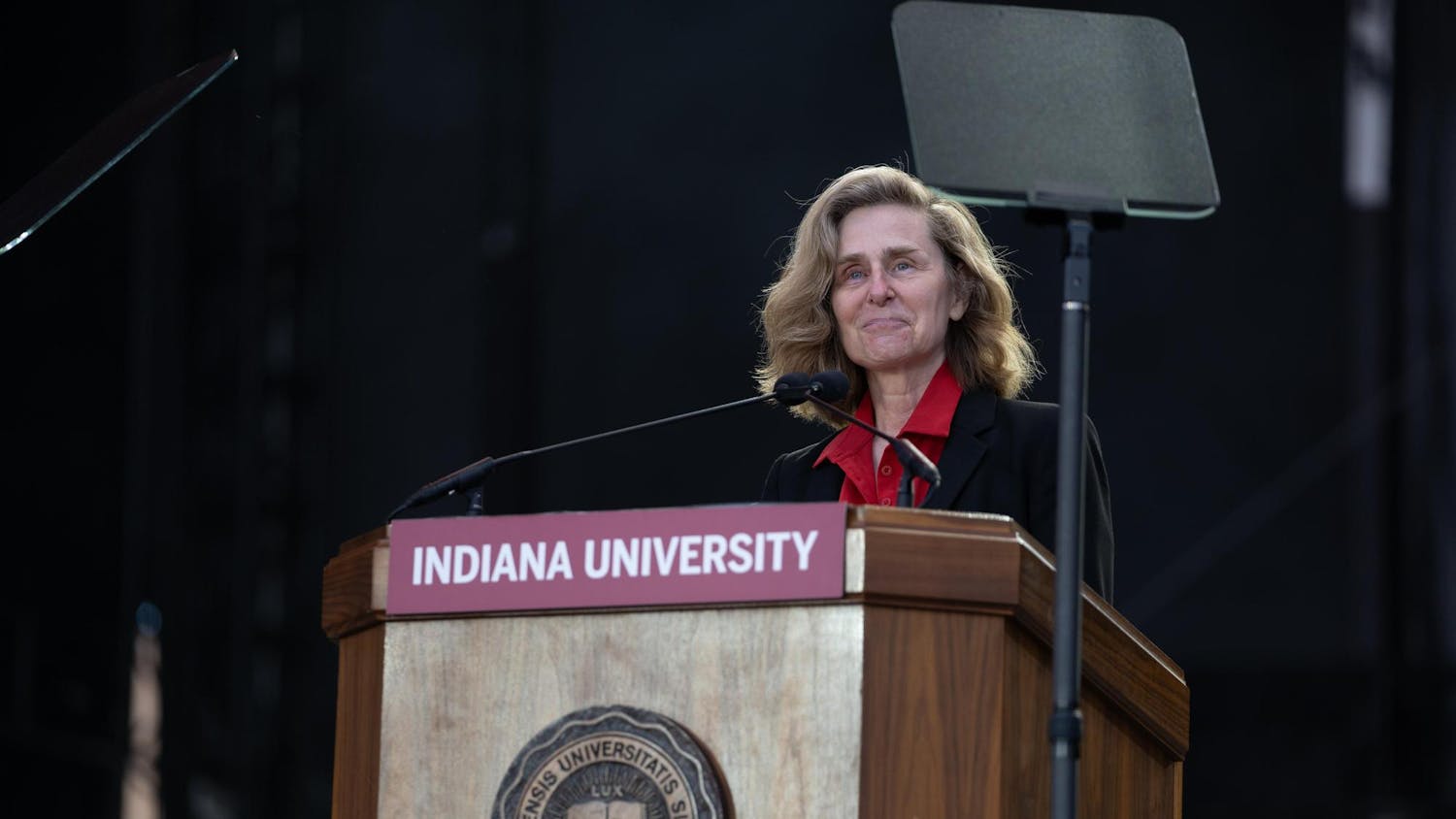IU Student Association:
IUSA is the student government representing mostly undergraduates, although it also represents graduate students with a few seats in Congress. IUSA has three branches: executive, Congress and the Supreme Court.
Executive: One executive ticket is elected by the student body each spring, comprised of four nominees, one for president, vice president of administration, vice president of Congress and treasurer, who run together. The president chooses a chief of staff, and these five people are the highest-ranking members of the executive branch. Below the top five executives are senior staff, such as advisers to the executives or policy chiefs. Below senior staff are staff members for various teams such as marketing or outreach. The executive works on policy/initiatives, carrying out congressional resolutions and working with various divisions on campus. The president serves on different committees on and off campus.
Congress: Congress members are elected for a one-year term at the same time as executives. There are 62 seats in Congress, each for different constituencies. Represented constituencies include residence centers, off-campus housing and academic units, such as the College of Arts and Sciences. Unfilled seats can be filled when Congress votes to approve the appointment of a specific person. Congress meets each week, alternating between committee meetings and general assembly voting meetings. Representatives write resolutions on which the body votes and work with the executive to carry out the passed bills. The speaker of congress is voted on within Congress each year, and he or she presides over meetings, receiving help in maintaining decorum from the parliamentarian, who is also internally selected.
Supreme Court: The Supreme Court of IUSA exists to review the constitutionality of IUSA actions or resolutions, make decisions in election disputes and certify election results. The Court consists of 10 associate justices and one chief justice, all appointed by the president and confirmed by Congress. Justices can serve up to the equivalent of three executive terms.
Executives:
President: Anne Tinder
Vice President of Congress: Jalen Watkins
Vice President of Administration: Tatiana Padilla
Treasurer: Wes Cuprill
Chief of Staff: Sara Zaheer
Senior Staff:
Adviser to the Vice President of Congress: Stephen Browne
Adviser to the Vice President of Administration: Libby Gress
Deputy Chief of Staff: Alex Ingoglia
Director of Freshman Intern Program and Deputy Treasurer: Dan Niersbach
Co-chiefs of Policy: Connor Brashear and Jessica Chiang
Chief of Outreach: Rebecca Yeakey
Co-chiefs of Marketing and Public Relations: Miko Siewenie and Paul Yoon
Chief of Diversity and Inclusion: Rob Sherrell
Director of Special Projects: Sam Gentry
Director of State and Legislative Affairs: Patrick Lockhart
(Below these positions are general staff members)
Congressional Seats:
Ashton Residence Center (1)
Briscoe Residence Center (1)
Kelley School of Business (4)
College of Arts and Sciences (5)
College of Arts and Sciences: School of Global and International Studies (1)
College of Arts and Sciences: Media School (1)
Collins Living-Learning Community (1)
Continuing Studies (1)*
School of Education (1)*
Eigenmann Residence Center (1)
Family Student Housing (1)*
Forest Residence Center (1)
Foster Residence Center (1)
Graduate School (2) (one of two unfilled)*
Greek Extension (1)
Greek North Jordan (1)
Greek South Campus (1)*
Honors Candidates (1)
School of Public Health (1)
School of Informatics and Computing (2)
Maurer School of Law (1)*
McNutt Residence Center (1)
Jacobs School of Music (1)
School of Nursing (1)
Off-campus residency (16)
School of Optometry (1)*
Read Residence Center (1)
Spruce Residence Center (1)
School of Social Work (1)*
School of Public and Environmental Affairs (1)
Teter Residence Center (1)*
Union Street Center (1)
University Division Students (6)
Willkie Residence Center (1)
Wright Residence Center (1)
(* means unfilled)
Congressional Committees: Oversight and Reform, Student Relations, Student Life, Education, Sustainability
Congressional Steering Committee: composed of chairpersons from each committee plus
speaker of the jouse
How a resolution moves through Congress:
1. One or more members of Congress write a bill, or a member of Congress chooses to sponsor a bill authored by a person from outside IUSA.
2. The bill is reviewed in a committee and then voted on by the committee.
3. If the bill passes in committee, it moves to review by the entirety of Congress.
4. The bill is read before Congress. Representatives ask questions, debate and can vote to amend the bill by a simple majority.
5. If Congress decides it will revisit the bill at a later date, it votes to “table” the bill. If it does not table the resolution, it moves to a vote.
6. By a simple majority, representatives can either pass or reject a resolution. If it is rejected, the bill stops its progress here.
7. If the bill passes, it moves to the president. The president must approve or veto the resolution within three days. If he or she does not do either, it is as if the president approved the bill.
8. If a resolution is vetoed, Congress can override the veto with a two-thirds majority approval vote in Congress.
9. If a resolution is approved by the president or by two-thirds of Congress after a presidential veto, the primary author meets with the adviser to the vice president of congress to create an implementation plan.
10. The implementation plan is carried out by meeting with appropriate offices on campus.
This process in action:
1. Congressman Andrew Guenther representing off-campus residency authored a bill proposing limits on executive stipends in proportion to IUSA’s total budget.
2. The Oversight and Reform Committee reviewed and modified the bill.
3. The committee passed the bill, so it went to Congress at the next voting meeting Sept. 29.
4. Congressmen asked Guenther questions and the resolution was debated at the meeting.
5. The body voted to table the resolution for later review.
6. The bill was reintroduced with slight modifications Nov. 10 and Congress again debated. It ultimately rejected the bill.
The Graduate and Professional Student Government represents graduate, professional and other post-baccalaureate students. GPSG is comprised of a legislative body called the Assembly, plus an executive committee comprised of four elected positions and four appointed positions.
Assembly: Members of the assembly come from various departments on campus. Each unit receives one voting representative for every 200 students in their department, or just one representative if they have less than 200 graduate or professional students. Each department can elect or appoint their representative. Assembly members serve on committees and communicate the needs of their constituent departments to the body. Representatives work on resolutions in committees and submit them to the entire assembly.
Executive steering committee: Assembly members vote for four executives at their March meeting: president, vice president, treasurer and parliamentarian. Winners take office in May. Then, four more executives are appointed: diversity officer, sustainability officer, awards officer and benefits officer. Together, these eight people form the executive committee. The executives meet as a part of the Assembly for voting meetings, with the president serving as the chair of the Assembly, although the executive committee also meets on its own. They lead committees, work to implement the resolutions voted on by the Assembly and overall guide the Assembly in its work. The president also serves on various committees on and off campus to provide a graduate perspective.
Committees: Benefits, Awards, Programming, Sustainability, Diversity and Health and Wellness.
1. A resolution is researched by one or more committees and written by a representative or committee officer.
2. The resolution is brought before the Assembly, and the representatives can ask questions, debate and vote to amend the bill.
3. The Assembly can vote to table the amendment for later consideration. If the resolution is not tabled, the Assembly moves to a vote to approve or reject the resolution.
4. A simple majority in favor passes the resolution, or a simple majority against the resolution rejects it.
5. If a resolution is passed, it heads to the president, who can decide to sign the bill, making it an official GPSG resolution, or not sign the bill. If he or she does not sign, the bill is essentially vetoed, though this has not happened recently, GPSG President Benjamin Verdi said.
This process in action:
1. The Benefits committee researched and wrote a resolution supporting the Apartment Family Student Council’s proposal for restored E bus service to College Mall.
2. Representatives discussed the bill at their meeting Oct. 2.
3. The assembly moved to a vote on the resolution.
4. The resolution passed with unanimous approval.
5. President Benjamin Verdi signed the resolution, officially positioning the bill to be enacted.
President: Benjamin Verdi
Vice President: Skyler Hutto
Treasurer: Nathan Harbison
Parliamentarian: Adam Reneker
Diversity Officer: Brittany Witherspoon
Awards Officer: Adrian Paneto
Benefits Officer: Benjamin Draper
Sustainability Officer: Kyle Norweg
Assembly Seats:
College of Arts and Sciences (37)*
African American and Diaspora Studies (1)
American Studies (1)
Anthropology (1)
Astronomy (1)
Biochemistry (1)
Biology (1)
Chemistry (1)
Classical Studies (1)
Cognitive Science (1)
Comparative Literature (1)
Criminal Justice (1)
Economics (1)
English (1)
Environmental Science (1)
Fine Arts (1)
Folklore (1)
French & Italian (1)
Gender Studies (1)
Geography (1)
Geological Sciences (1)
Germanic Studies (1)
History & Philosophy of Science (1)
History (1)
Linguistics (1)
Mathematics (1)
Neural Science (1)
Philosophy (1)
Physics (1)
Psychology (1)
Religious Studies (1)
Second Language Studies (1)
Slavic Languages (1)
Sociology (1)
Spanish & Portuguese (1)
Speech & Hearing (1)
Statistics (1)
Theater & Drama (1)
SGIS (6)*
African Studies (1)
Central Eurasian (1)
East Asian Language and Culture (1)
Latin American Studies (1)
Near Eastern Language and Culture (1)
Russian and East European Studies (1)
SPEA (4)*
Kelley (6)*
Business System and Accounting (2)
Business Administration (3)
Business Ph.D. (1)
Media School (3)*
Communication and Culture (1)
Journalism (1)
Telecommunications (1)
School of Education (6)*
School of Informatics and Computing (5)*
Computer Science (2)
Informatics (2)
Information and Library Science (1)
School of Law (4)*
School of Medicine (1)*
School of Music (7)*
Music PD (performer’s diploma) (2)
Music (Theory) (1)
Music (Instrumental) (1)
School of Public Health (4)*
Applied Health (1)
Kinesiology (1)
Recreation (1)
Public Health Ph.D. (1)
School of Optometry (2)*
International Representatives: 5*
Diversity Council Representatives: 5*
Total: 95
To quorum: 32
Buzzwords:
Quorum: minimum number of people each legislative body decides must be in attendance for a vote to occur. A quorum exists so votes are representative of the student body, not just a small portion of the student body.
IUSA Congress requires more than half of active members be present to meet quorum.
GPSG’s Assembly requires one-third of active members be present to meet quorum.
Resolution: a piece of legislation that asks for action, a change to the bylaws or declares a position on an issue.
Examples: Action: an IUSA resolution passed this year requested staplers be placed at printers.
Change to Bylaw: A GPSG resolution passed this year modified the bylaws to reflect the change of the Student Affairs committee into the Health and Wellness committee.
Declare position: An IUSA resolution passed this year declared IUSA was against discrimination of any kind based on ethnicity, religion, gender or another similar criteria.
Constituency: the group of people a congressman or Assembly member represents.
If a person represents the School of Informatics and Computing for IUSA Congress, their constituency is all the undergraduate students in the School of Informatics and Computing.
Executive stipend: a payment given to executives. For IUSA, the president, vice president of Congress, vice president of administration, treasurer and Chief of Staff all receive executive stipends credited toward their bursars. GPSG executives also receive stipends.
Simple majority: one more than half of a given body. If 50 members of Congress attend a given voting meeting, 26 is a simple majority.
Proxy: a person who attends a Congress or Assembly meeting if a congressman/representative cannot attend. They must be from the same constituency as the absent representative.





